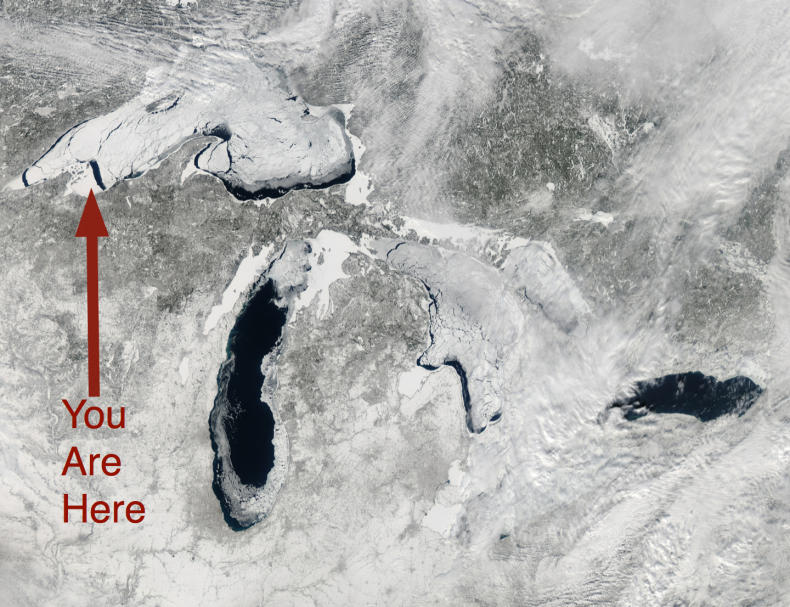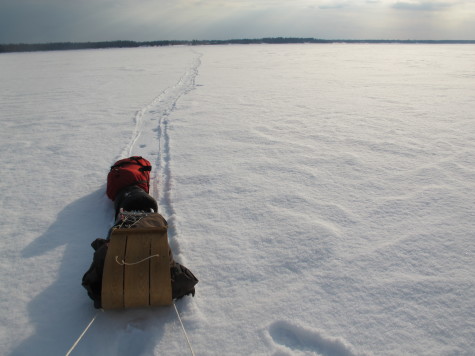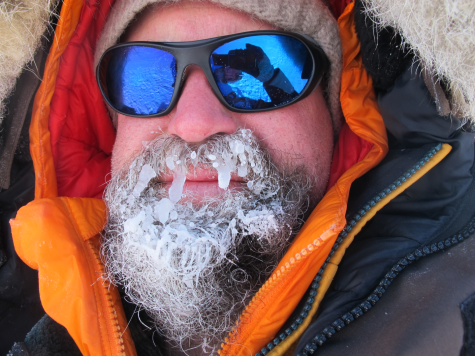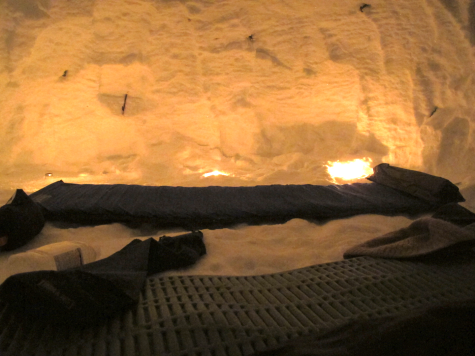 This time last year, most of North America was buried in an unusual cold period. The jet stream had hemorrhaged in early January and the Polar Vortex that usually sits atop the hemisphere like a halo came pouring down. Known as the 2014 North American Cold Wave, temperatures plummeted, particularly in the Northeast and Upper Midwest where double digits below 0 °F appeared for weeks. Lake Superior froze more solidly than it had in decades.
This time last year, most of North America was buried in an unusual cold period. The jet stream had hemorrhaged in early January and the Polar Vortex that usually sits atop the hemisphere like a halo came pouring down. Known as the 2014 North American Cold Wave, temperatures plummeted, particularly in the Northeast and Upper Midwest where double digits below 0 °F appeared for weeks. Lake Superior froze more solidly than it had in decades.
That’s when I went to the Superior shore of northern Wisconsin where nearby temperatures had reached -37 °F. If I wanted to get the feel of a cold spell, I figured this was my moment. At the time, I was writing about the Younger Dryas, a cold anomaly that hit the Northern Hemisphere 12,800 years ago and continued for a thousand years. The world at that point had been gradually warming, the Ice Age coming to an end. Suddenly, within the space of a decade, ocean currents reversed in the Atlantic, probably triggered by cold, meltwater flows coming off the shrinking Laurentide Ice Sheet. This reversal sent the world back into the Ice Age, and brought the end of the Clovis tradition in North America, the climate upheaval speeding up megafauna extinctions.
I don’t like writing about events without witnessing them, so I set off across frozen Lake Superior out of Ashland, Wisconsin, pulling a sled behind me with enough gear to last several days. I wanted a taste of the Younger Dryas.
The Polar Vortex event in 2014 was a miniature version of the Younger Dryas, the best analog I could find. Rather than lasting a thousand years, it continued for the remainder of winter and into spring, the Great Lakes remaining partially frozen into April.
This cold wave was the result of sudden stratospheric warming that began on January 2, 2014. Winds in the stratosphere reversed direction, becoming easterly near the Arctic Circle. This change in direction disrupted polar winds, sending them down across southern Canada and the United States.
Winds and a blustery snow came out of the northwest across the frozen waste of Lake Superior. Afternoon air temperature was -10 °F. I had marched about six miles with my sled when the dithering squalls blew off and the sky opened wide. It was late in the day, and I decided to set my first camp.
I wasn’t actually in contact with the ice. The surface of the lake was drifted with crusty snow. A crescent moon resolved in the west as the last light faded. Buried in more layers than I could count, the ruff of my anorak pulled around my face, I watched the sky fill with stars, temperature dropping to -20 °F.
I didn’t have a tent. I was going bare bones, Pleistocene style, or at least what I thought was Pleistocene style. Paleolithic stone tools had been found in the nearby Boundary Waters in Minnesota. Dating to 12,000 years ago, these tools put people here smack in the Younger Dryas. I figured our bodies haven’t changed that much since then. If Stone Age foragers were in the area for that cold spell, I could be here for this one.
It turned out to be one of the worst nights I have ever experienced, frigid and uncomfortable. Any colder and I’d have lost digits. I was clearly the dumb Holocene guy trying out the Ice Age.
In the morning, it took an hour for me to break ice from around the zippers on my sleeping bag, and then the bivvy-shell encased around that. I emerged into clear morning sunlight which was, to my disappointment, not warm at all. Having not slept even once that night, I was grumpy and yelled at my tools. It took 45 minutes to work up enough hand warmth to assemble the stove, and another ten minutes of gloves on, gloves off, to ignite chilled liquid fuel.
A second night would not have been worth it. I pulled the plug on the journey across the lake and retreated to shore. By dark I reached a snow shelter I had built with students from nearby Northland College a couple days earlier. We had piled up snow, stomped it down, and hollowed out a spacious chamber inside. The entrance was a narrow passage dropping below floor-level to keep the cold out. I slithered in, pushing gear ahead, the cone of my headlamp shining across a smooth, snow-packed floor. The students had left tea candles from when they spent the night. Soon I had a circle of small, flickering flames around me. The inside of the white, silent shelter glowed.
Over the next hour, my thermometer went up to -10 °F, almost balmy. Zippers undone, coats opened, hats pulled off, I wondered how many people waited out the Younger Dryas in similar fashion. How many of the first people breathed under the snow, stone or shell lamps filled with animal fat letting warmth into their spaces?
When the last candle finally sputtered out, the space became as dark as the inside of a clam shell buried in winter mud. I crawled into my bag where I fell into one of the deepest, soundest sleeps I will ever have, the cold settling hard outside.
Photos: NASA, Craig Childs


This is fascinating stuff. Based on this experience, would you revise your assessment of how people in the Pleistocene actually lived? Would your choice of an exposed sleeping place have been a critical factor?
Caribou hide shelters. These animals were plenty in the Great Lakes region at the end of the Wisconsin Ice Age.